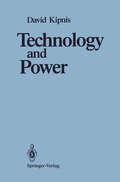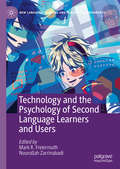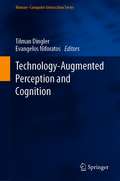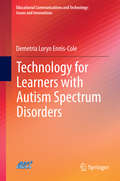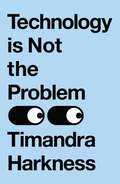- Table View
- List View
Technology and Mental Health: A Clinician's Guide to Improving Outcomes (Clinical Topics in Psychology and Psychiatry)
by Greg M. RegerTechnology and Mental Health provides mental health clinicians with expert, practical, clinical advice on the questions and considerations associated with the adoption of mental health technology tools in the computer age. Increasingly, clinicians want to use technology to provide clients support through smartphones and mobile applications or to reach clients in remote or rural areas. However, using these tools in practice raises many practical and ethical questions. The book explains current technological developments in therapy, including mobile apps, telemental health, and virtual reality programs. Each chapter gives real-world guidance on adopting and using technology interventions, and the book spans a wide range of populations. Providers are introduced to the evidence supporting various technology-based interventions and areas for future development. Combining theory, research, and case studies, this practical guide teaches clinicians how to integrate technology into therapeutic interventions with clients.
Technology and Mental Health: A Clinician's Guide to Improving Outcomes (Clinical Topics in Psychology and Psychiatry)
by Greg M. RegerTechnology and Mental Health provides mental health clinicians with expert, practical, clinical advice on the questions and considerations associated with the adoption of mental health technology tools in the computer age. Increasingly, clinicians want to use technology to provide clients support through smartphones and mobile applications or to reach clients in remote or rural areas. However, using these tools in practice raises many practical and ethical questions. The book explains current technological developments in therapy, including mobile apps, telemental health, and virtual reality programs. Each chapter gives real-world guidance on adopting and using technology interventions, and the book spans a wide range of populations. Providers are introduced to the evidence supporting various technology-based interventions and areas for future development. Combining theory, research, and case studies, this practical guide teaches clinicians how to integrate technology into therapeutic interventions with clients.
Technology and National Identity in Turkey: Mobile Communications and the Evolution of a Post-Ottoman Nation (International Library of Cultural Studies)
by Burce CelikIntroduced in 1994 when Turkey was experiencing one of the worst economic crises in its history, the nation now has 67 million mobile users and the largest second-hand market for mobile phones in the world. Innovative and groundbreaking yet based in established psychoanalytic and poststructuralist theory, Burçe Çelik analyses the factors that transformed mobile communications in Turkey from a tool into a technology and the collective desires and anxieties wrapped up in embracing it. Often described as Turkey's 'national organ' in the press, the mobile phone is now a requirement for a Turkish citizen wishing to inhabit a social space and 'be anywhere'. Technology and National Identity in Turkey interrogates the sociological conditions unique to Turkey to explain the mutation of mobile phones from a foreign technology to an object of collective addiction. Freud's Mourning and Melancholia and Butler's work on identity and loss inform the exploration of Turkey's foundation as a modern and secularised nation, distinct from its Ottoman past and yearning for modernity, in which the mobile phone becomes a means of showing off for the imagined western gaze. This collective post-empire melancholia and Turkey's status as a 'developing' country where east and west are in constant negotiation, contributes to the social, psychological and political promises of mobile technologies. This book goes beyond the mobile as a device of greater utility or a reflection of social status to an object whose lack is a source of anxiety and depression, a conception of cellular telephony as a dream of presence and being in an unfamiliar, uncertain and out-of-place world. Drawing on cultural theory, the philosophy of technology and extensive first-hand interviews with mobile users and technocrats, Celik argues that Turkey's adoption of mobile technologies, initially a melancholic strategy, has become the means of fashioning a new conception of what it means to be Turkish.
Technology and Power
by David KipnisThere is a dark side to human nature that is nurtured by the control of power. In an earlier book, The Powerholders, I I described several psychological principles that appear to govern the behavior of people who control and use social power. In particular, I examined how the successful use of power transformed, for the worse, the values and behavior of the influencing agent. My interest in the relation between technology and power grew out of reading David Howarth's Tahiti: A Paradise Lost,2 a description of the almost causal ways in which Western technology was used by early explorers and traders to obliterate the Tahitian civilization. In reflecting on what happened in Tahiti, what struck me was the similarity in the behavior of these explorers and traders to the behavior of the husbands, wives, and businessmen, in positions of power, that I wrote about in my earlier book. Technology and Power is concerned with the issue of how the added power provided by technology changes the behavior of people who control it. I describe these changes among managers at work, psychologists, physicians, and colonists. What unifies these disparate areas is the implacable logic of power. The seeming ease with which power promotes the derogation of those controlled by power provides, I believe, a needed perspective for viewing the many social problems generated by technology.
Technology and Testing: Improving Educational and Psychological Measurement
by Fritz DrasgowFrom early answer sheets filled in with number 2 pencils, to tests administered by mainframe computers, to assessments wholly constructed by computers, it is clear that technology is changing the field of educational and psychological measurement. The numerous and rapid advances have immediate impact on test creators, assessment professionals, and those who implement and analyze assessments. This comprehensive new volume brings together leading experts on the issues posed by technological applications in testing, with chapters on game-based assessment, testing with simulations, video assessment, computerized test development, large-scale test delivery, model choice, validity, and error issues. Including an overview of existing literature and ground-breaking research, each chapter considers the technological, practical, and ethical considerations of this rapidly-changing area. Ideal for researchers and professionals in testing and assessment, Technology and Testing provides a critical and in-depth look at one of the most pressing topics in educational testing today.
Technology and Testing: Improving Educational and Psychological Measurement
by Fritz DrasgowFrom early answer sheets filled in with number 2 pencils, to tests administered by mainframe computers, to assessments wholly constructed by computers, it is clear that technology is changing the field of educational and psychological measurement. The numerous and rapid advances have immediate impact on test creators, assessment professionals, and those who implement and analyze assessments. This comprehensive new volume brings together leading experts on the issues posed by technological applications in testing, with chapters on game-based assessment, testing with simulations, video assessment, computerized test development, large-scale test delivery, model choice, validity, and error issues. Including an overview of existing literature and ground-breaking research, each chapter considers the technological, practical, and ethical considerations of this rapidly-changing area. Ideal for researchers and professionals in testing and assessment, Technology and Testing provides a critical and in-depth look at one of the most pressing topics in educational testing today.
Technology and the Psychology of Second Language Learners and Users (New Language Learning and Teaching Environments)
by Nourollah Zarrinabadi Mark R. FreiermuthThis edited volume brings together large-scale research as well as case studies from a range of geographical contexts and represents a variety of educational settings involving second language learners and users. Its aim is to explore the interrelated issues of psychology and technology use in second language learning settings as well as in more autonomous environments. As language learning professionals continue to devote more time and attention to making various technological tools an integral part of the classroom, it is just as important to understand the influences that these tools have on the psychological state of the learners who use them. In consideration of this objective, the volume examines factors such as learner attitudes and motivation, emotion and behaviour, and the cognitive processes that are at play in the minds of the language users. This volume will be of interest not only to language teachers but also to researchers working in second language acquisition (SLA), applied linguistics, and educational psychology.
Technology and the Soul: From the Nuclear Bomb to the World Wide Web, Volume 2 (The Collected English Papers of Wolfgang Giegerich)
by Wolfgang GiegerichC. G. Jung famously declared that it is not the psyche that is in us, but rather we who are in the psyche. Updating this insight, the second volume of Wolfgang Giegerich’s Collected English Papers examines what must be regarded as the most all-encompassing presence of our lives today: technological civilization. Living within technology, we now find that what we had formerly regarded as psychological phenomena—our feelings and emotions, images and dreams—have been superseded by phenomena bearing the predicates "artificial," "manufactured," and "virtual." Television, the World Wide Web, and the nuclear bomb are cases in point. Far from being mere things among things, each of these has transformed the whole of man’s world-relation. Though deplored by many as soulless on this account, these phenomena, it may be argued, are the real gods, the real archetypes, of the soul today. Psychologically it is not what we think and feel about them that counts, but what they think, what they feel.
Technology and the Soul: From the Nuclear Bomb to the World Wide Web, Volume 2 (The Collected English Papers of Wolfgang Giegerich)
by Wolfgang GiegerichC. G. Jung famously declared that it is not the psyche that is in us, but rather we who are in the psyche. Updating this insight, the second volume of Wolfgang Giegerich’s Collected English Papers examines what must be regarded as the most all-encompassing presence of our lives today: technological civilization. Living within technology, we now find that what we had formerly regarded as psychological phenomena—our feelings and emotions, images and dreams—have been superseded by phenomena bearing the predicates "artificial," "manufactured," and "virtual." Television, the World Wide Web, and the nuclear bomb are cases in point. Far from being mere things among things, each of these has transformed the whole of man’s world-relation. Though deplored by many as soulless on this account, these phenomena, it may be argued, are the real gods, the real archetypes, of the soul today. Psychologically it is not what we think and feel about them that counts, but what they think, what they feel.
Technology and the Treatment of Children with Autism Spectrum Disorder (Autism and Child Psychopathology Series)
by Teresa A. CardonThis volume analyzes recent technological breakthroughs in aiding children with autism spectrum disorder (ASD). Chapters offer practical guidance in such areas as assessment, treatment planning, and collaborative intervention. The book also presents findings on hardware and software innovations and emphasizes their effectiveness in clinical practices that are targeted to specific cognitive, social, academic and motor skill areas. In addition, it describes promising new deficit-reducing and skill-enhancing technologies on the horizon.Featured topics include:Developing and supporting the writing skills of individuals with ASD through assistive technologies.The ways in which visual organizers may support executive function, abstract language comprehension and social learning.Do-as-I’m-doing situations involving video modeling and autism.The use of technology to facilitate personal, social and vocational skills in youth with ASD.Evidence-based instruction for students with ASD.The use of mobile technology to support community engagement and independence.Technology and Treatment of Children with Autism Spectrum Disorder is an essential resource for clinicians and related professionals as well as researchers and graduate students across such disciplines as child and school psychology, rehabilitation medicine, educational technology, occupational therapy, speech pathology and social work.
Technology as Symptom and Dream
by Robert RomanyshynThe development of linear perspective in the 15th century represented a radical transformation in the European's sense of the world, the body and the self. Robert Romanyshyn's latest book examines the claim that the development of linear perspective vision was and is indispensable to the emergence of our technological world. It does so by telling the story of how an artistic technique has become a cultural habit of mind.
Technology as Symptom and Dream
by Robert RomanyshynThe development of linear perspective in the 15th century represented a radical transformation in the European's sense of the world, the body and the self. Robert Romanyshyn's latest book examines the claim that the development of linear perspective vision was and is indispensable to the emergence of our technological world. It does so by telling the story of how an artistic technique has become a cultural habit of mind.
Technology-Assisted Interventions for Substance Use Disorders
by Jonathan Avery Mashal KhanThis book examines the role of technology-assisted interventions for substance use disorders (SUD). It considers this topic alongside the dramatic increase in SUDs and associated harm in the United States’ past decade.Chapters relay the impact and effectiveness of technology-assisted interventions, which include telemedicine, assisted therapies, and support. These treatments not only offer practical care but also address the issue of access to care, particularly in the wake of the global pandemic (COVID-19). Organized into three sections, section one covers the use of telemedicine and technology-assisted therapies as it relates to the treatment of various SUDs, achieving recovery and maintenance. Each chapter will expand on a specific aspect of technology-assisted intervention. Following this, section two explores the differences in technology-assisted interventions and approaches while taking into account age, gender, sexuality, identity, and psychosocial factors. This section will be divided into chapters on children and adolescents, women and pregnancy, older adults, LGBTQIA+, and professionals. To close the book, section three discusses the media impact on SUDs and the legal technology adopted by drug courts.Unique and timely, Technology-Assisted Interventions for Substance Use Disorders is an invaluable resource to learners and practitioners in the field. It provides a concise yet comprehensive summary of the current status of the field that will help guide the implementation of technology-assisted interventions for all SUDs into practice and stimulate investigative efforts.
Technology-Augmented Perception and Cognition (Human–Computer Interaction Series)
by Tilman Dingler Evangelos NiforatosTools and technologies have long complemented and extended our physical abilities: from pre-historic spearheads to steam-propelled ploughs and high-tech prosthetics. While the development of lenses granted us insights into the micro and macrocosms, new sensors and technologies increasingly augment our cognitive abilities, including memory and perception. This book integrates current research efforts, results, and visions from the fields of computer science, neuroscience, and psychology. It provides a comprehensive overview of the state-of-the-art and future applications of how technologies assist and augment human perception and cognition. Experts in the field share their research and findings on: Working memory enhancementsDigitization of memories through lifelog archivesThe consequences of technology-induced disruptions and forgettingThe creation and utilization of new human senses Ethical and security concerns that arise with augmentation technologies. As technology weaves itself ever deeper into our lives, careful examination of its capabilities, risks and benefits is warranted. While this book focuses on the complementation and augmentation of human capabilities, it serves as a foundation for students, researchers and designers of technologies that push the boundaries of perception and cognition.
Technology-Enhanced Learning: Principles and Products
by Nicolas Balacheff Sally Barnes Ard Lazonder Sten Ludvigsen Ton De De JongTechnology-enhanced learning is a timely topic, the importance of which is recognized by educational researchers, practitioners, software designers, and policy makers. This volume presents and discusses current trends and issues in technology-enhanced learning from a European research and development perspective. This multifaceted and multidisciplinary topic is considered from four different viewpoints, each of which constitutes a separate section in the book. The sections include general as well as domain-specific principles of learning that have been found to play a significant role in technology-enhanced environments, ways to shape the environment to optimize learners’ interactions and learning, and specific technologies used by the environment to empower learners. An additional section discusses the work presented in the preceding sections from a computer science perspective and an implementation perspective. This book comes out of the work in Kaleidoscope: a European Network of Excellence in which over 1,000 people from more than 90 institutes across Europe participate. Kaleidoscope brings together researchers from diverse disciplines and cultures, through their collaboration and sharing of scientific outcomes, they are helping move the field of technology-enhanced learning forward.
Technology for Learners with Autism Spectrum Disorders (Educational Communications and Technology: Issues and Innovations)
by Demetria Loryn Ennis-ColeTechnology for Learners with Autism Spectrum Disorders provides readers with an in-depth look at the characteristics of learners with ASD and explains how different forms of technology can be used to create learning opportunities for autistic students. The book is both academic and practical to appeal to multiple audiences: academicians, parents, teachers and therapists. Currently, there is scant literature speaking to the types of academic activities that should be developed and used to help children with ASD gain skills in academic areas: reading, writing, effective communication and mathematics. This book fills that void by including sample academic activities, explaining strategies for working with children diagnosed with ASD and examining ways a variety of technology tools can be used. All of the activities are visually appealing and they have been used with learners diagnosed with ASD.
Technology in Counselling and Psychotherapy: A Practitioner's Guide
by Kate AnthonyOver recent years information technology has become an increasingly important part of counselling and psychotherapy. This innovative and broad-ranging text, with contributions from internationally leading figures, provides an up-to-the-minute, precise and practical guide to the different ways in which technology can be used in therapeutic work, including e-mail and internet relay chat; telephone; video-link and stand-alone software packages. As well as discussing vital ethical, theoretical and practical considerations for practitioners, the authors look at the likely impact of these technologies on therapeutic relationships and the outcomes that can be expected. Technology's impact is explored from the perspectives of both therapists and clients, including individual therapy, groups, supervision and training, and supported by extensive case studies.
Technology in Mental Health: Foundations of Clinical Use (Routledge Focus on Mental Health)
by Jessica StoneTechnology in Mental Health focuses on the responsible integration of technology into therapy in a world affected by COVID. Author Jessica Stone discusses the pandemic’s effects on the mental health field, historical fundamentals, and possible future implications. Chapters also explore legal and ethical considerations as well as educational and supervision needs. Seasoned and new clinicians alike will find valuable information in these pages as they progress from traditional to modern to post-COVID mental health treatment.
Technology in Mental Health: Foundations of Clinical Use (Routledge Focus on Mental Health)
by Jessica StoneTechnology in Mental Health focuses on the responsible integration of technology into therapy in a world affected by COVID. Author Jessica Stone discusses the pandemic’s effects on the mental health field, historical fundamentals, and possible future implications. Chapters also explore legal and ethical considerations as well as educational and supervision needs. Seasoned and new clinicians alike will find valuable information in these pages as they progress from traditional to modern to post-COVID mental health treatment.
Technology Innovations for Behavioral Education
by Mary Banks Banks GregersonBehavioral and technological innovation has a special place in the future of graduate and medical education, both for students and for educators. A new multi-media pedagogy offers innovative techniques and technologies, drawing widely upon behavioral science. The psychology of multi-media education maximizes learning by involving many different sensory modalities. Although multi-media has long meant use of film and other electronic modality adjuncts like Powerpoint, newer technologies expand these horizons further. Now multi-media pedagogy means not only newer technologies, but also newer, and different education techniques. This book describes psychology innovation currently making educational settings competent and competitive. Student choice rules in education today. The technologically driven environment produces students whose preference is incumbent on electronic research means. Besides using these tools themselves, students thirst for multi-media pedagogy in the classroom online and on campus. It is therefore teachers who close the digital divide between generations in order to educate effectively. Approaches using new technologies and techniques have proven successful internationally with diverse audiences.
Technology is Not the Problem
by null Timandra HarknessWe already know how much of our data is collected and used to profile and target us. The real question is why, knowing all this, do we keep going back for more? “Great book” – Matt Ridley, author of How Innovation Works “Essential reading” – Pete Etchells, author of Unlocked “An urgent must-read” – Tiffany Jenkins, author and broadcaster, presenter of BBC Radio 4’s A History of Secrecy Technology has delivered a world that we expect to revolve around us, our needs and preferences, and our unique personalities. We willingly hand over intimate information about ourselves in return for a world that’s easier to navigate. We live in the Personalised Century, where we view ourselves in terms of what rather than who we are – the objects of others’ recognition, rather than the subjects and authors of our own lives. Is this a sign of our shrinking sense of self? Interrogating the historical currents that have brought us here, Harkness envisages a messier, riskier and less comfortable world than the one into which we’re sliding. Challenging readers to look at what’s missing from their personalised menus, Technology is not the Problem encourages us to look afresh at the familiar: not just the technology we use every day, how we relate to the world and those around us.
Technology-mediated Learning During the Pandemic: Challenges vs Outcomes
by Vikas Kumar Jitendra SinghThis volume discusses the emergence of information and communication technology (ICT)-based teaching and learning during the Covid-19 pandemic as a potential alternative to traditional classroom-based learning. It presents a collection of theories, practices, and case studies from across the globe and covers different aspects of education from a multidisciplinary perspective.While focusing on the various opportunities that surfaced while carrying out innovative experiments in the online learning space, the book discusses pedagogical challenges and the need for a shift in teaching pedagogy towards online learning. It outlines the existing learning theories, reasons behind their failure, and new theories that emerged to fill the need for new methods for delivery of content and pedagogy. The book discusses the issues faced by stakeholders, including institute administrators, students, and teachers to prepare for this new method of teaching and learning. It highlights the role of virtual laboratories in supplementing the needs of students in the remote learning environment. The book also discusses the role and impact of social media as a powerful tool of learning and educational communication.This book will be of interest to teachers, students, and researchers of education, higher education, digital education, information technology, educational psychology, and media studies. It will also be useful for courses on e-learning, educationalists, policymakers, educational institutions, online education centres, and practitioners working in the related areas.
Technology-mediated Learning During the Pandemic: Challenges vs Outcomes
This volume discusses the emergence of information and communication technology (ICT)-based teaching and learning during the Covid-19 pandemic as a potential alternative to traditional classroom-based learning. It presents a collection of theories, practices, and case studies from across the globe and covers different aspects of education from a multidisciplinary perspective.While focusing on the various opportunities that surfaced while carrying out innovative experiments in the online learning space, the book discusses pedagogical challenges and the need for a shift in teaching pedagogy towards online learning. It outlines the existing learning theories, reasons behind their failure, and new theories that emerged to fill the need for new methods for delivery of content and pedagogy. The book discusses the issues faced by stakeholders, including institute administrators, students, and teachers to prepare for this new method of teaching and learning. It highlights the role of virtual laboratories in supplementing the needs of students in the remote learning environment. The book also discusses the role and impact of social media as a powerful tool of learning and educational communication.This book will be of interest to teachers, students, and researchers of education, higher education, digital education, information technology, educational psychology, and media studies. It will also be useful for courses on e-learning, educationalists, policymakers, educational institutions, online education centres, and practitioners working in the related areas.
Technology Play and Brain Development: Infancy to Adolescence and Future Implications
by Doris Bergen Darrel R. Davis Jason T. AbbittTechnology Play and Brain Development brings together current research on play development, learning technology, and brain development. The authors first navigate the play technology and brain development interface, highlighting the interactive qualities that make up each component. Next, they survey the changes in play materials and the variations in time periods for play that have occurred over the past 15-20 years, and then explain how these changes have had the potential to affect this play/brain developmental interaction. The authors also cover various types of technology-augmented play materials used by children at age levels from infancy to adolescence, and describe the particular qualities that may enhance or change brain development. In so doing, they present information on previous and current studies of the play and technology interface, in addition to providing behavioral data collected from parents and children of varied ages related to their play with different types of play materials. Significantly, they discuss how such play may affect social, emotional, moral, and cognitive development, and review futurist predictions about the potential qualities of human behavior needed by generations to come. The authors conclude with advice to toy and game designers, parents, educators, and the wider community on ways to enhance the quality of technology-augmented play experiences so that play will continue to promote the development of human characteristics needed in the future.
Technology Play and Brain Development: Infancy to Adolescence and Future Implications
by Doris Bergen Darrel R. Davis Jason T. AbbittTechnology Play and Brain Development brings together current research on play development, learning technology, and brain development. The authors first navigate the play technology and brain development interface, highlighting the interactive qualities that make up each component. Next, they survey the changes in play materials and the variations in time periods for play that have occurred over the past 15-20 years, and then explain how these changes have had the potential to affect this play/brain developmental interaction. The authors also cover various types of technology-augmented play materials used by children at age levels from infancy to adolescence, and describe the particular qualities that may enhance or change brain development. In so doing, they present information on previous and current studies of the play and technology interface, in addition to providing behavioral data collected from parents and children of varied ages related to their play with different types of play materials. Significantly, they discuss how such play may affect social, emotional, moral, and cognitive development, and review futurist predictions about the potential qualities of human behavior needed by generations to come. The authors conclude with advice to toy and game designers, parents, educators, and the wider community on ways to enhance the quality of technology-augmented play experiences so that play will continue to promote the development of human characteristics needed in the future.


